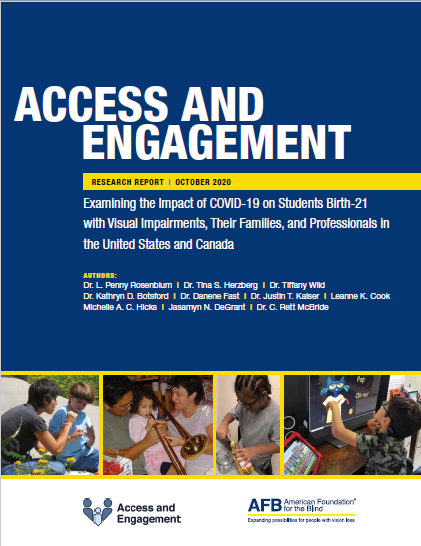
As the Director of Research at AFB, I spend 8-10 hours a day in front of a computer screen five days a week and often 10+ hours over the weekend. As someone with low vision, all that screen time is tough, especially when I have a visually demanding task or have to learn a new program. The latest one for me is Trello, a tool AFB is now using to track projects. Where exactly is the button I need to start a new project? It took me a lot longer to find it than my sighted colleagues. Frustrating!
The stress of so much online time is being experienced by many students with visual impairments, family members/guardians, teachers of students with visual impairments (TVIs), and orientation and mobility (O&M) specialists. Yet for other students, the one-on-one time, their family members having a better understanding of what they are learning, and the safety of being home have been advantageous.
Yet, today as I looked through some of the comments from TVIs and O&M specialists taking part in the second Access and Engagement study, the words “overwhelmed,” “isolation,” and “uncertainty” were repeated over and over. One TVI shared:
“It's frustrating and isolating for [students]. They miss out on a lot of social interactions during a "regular" school day. They miss even more during distance learning. Access is a HUGE issue for VI, DHH, and DB students.”
The impact of distance learning on families is also taking its toll, as explained by a dually certified professional.
“I see [parents] are very stressed and a lot of them are trying very hard. If parents are working from home they are working two jobs at the same time by supporting their children. A lot of my time is spent coaching them with how to support my lessons and IEP goals in the home.”
Do you have thoughts about how COVID-19 is impacting your own child or the children with whom you work? Do you want to be part of the solution? If so, by November 30 please take the second Access and Engagement survey. We have collected data from more than 600 family members, guardians, TVIs, and O&M specialists in the U.S. and Canada, but we need more voices to have a statistically significant sample. We had 1,432 participants in our spring study, and data from that study is helping to shape the education of our students now and in the future.
Jon Harding, Superintendent of the Kansas School for the Blind, shared, “I am putting it [the report from the first Access and Engagement study] to use next week at a budget hearing with the Governor's Office. Like many schools, we are facing some proposed cuts, and the report will help us explain that this remains a perilous time for students who are B/VI [blind or low vision].”
This is a perilous time! As one TVI shared in our current study, open until November 30, “I question how it took a global pandemic to realize how bad accessibility is. And I question, after all of this, what is going to be done about it to hold these platforms accountable and moving towards accessibility for all.”
Together, we can work to make changes, but we need your voice and the voices of all family members/guardians, TVIs, and O&M specialists of children in early intervention, preschool, K-12, and transition services. Please take the survey and share the opportunity with others. Even if they are overwhelmed, let it be their choice if they opt to add their voice. Don’t make the choice for them.